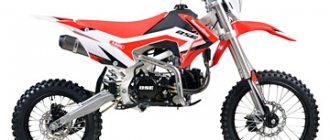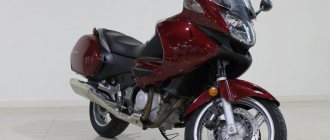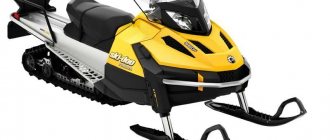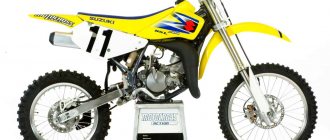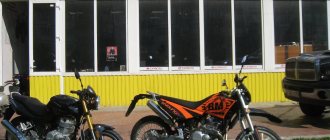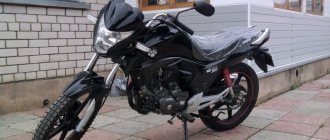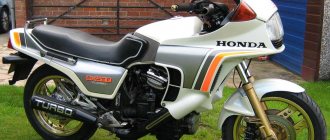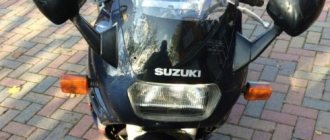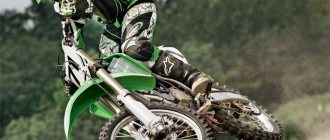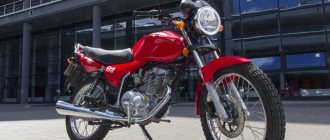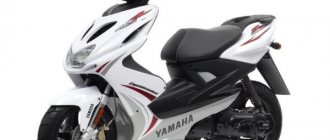000_moto_1211_038
The world's popular class of pit bikes - small cross-country motorcycles with 4-stroke "Cab" engines - has finally come to us. Moreover, during this delay two important events occurred. Firstly, Chinese motorcycle manufacturers took over their production and significantly reduced prices. But the most important thing is that with their help the class has evolved. After all, classic pit bikes (dating back to the Honda CRF50) on 10-inch wheels are, frankly speaking, too small. And the “filling” there is artificially archaic - drum brakes and a 3-speed gearbox. This type of device is offered in the Western markets by Honda, Yamaha, Kawasaki, and Suzuki.
Today, cars from the Middle Kingdom are imported into our country, not constrained by the traditions of pit bikers. They are cheaper than the “brand” ones and, moreover, a little larger, with modern “disc wheels” and more advanced suspensions. A noticeable share among them is occupied by the “Clip” of “Cartridges”, which is offered by the Ural Motorcycle Company. Three models are built on one platform (with a 125 cc engine) - for cross-country, enduro and motard on road tires. The last two options are with lighting devices and an electric starter. In principle, they could be driven on the roads if they came with a title. And so they fall into the category of sports cars and are cheaper for the buyer.
The basis of the devices is the “Kab” engine, which is “inflated” here to 125 cm³ - the limit that the standard crankcase allows (for more information about these engines, see “Moto” No. 12–2009). An aluminum lined cylinder is used (in small-capacity models it is cast iron), a head with more developed fins. The clutch is like on motorcycles, “manual”. There are 4 gears in the box, however, the order in which they are engaged is specific: when accelerating, everything goes down.
Frame, seat, tank, wheels - everything is larger than on classic pit bikes. Motorcycles are not only suitable for children over 10 years old, but they can also accommodate adults. True, the weight is nominally limited to 75 kg, but this is if the motos are used for their intended purpose - for “annealing”. There is a caveat for very young children: they must ride under the supervision of a trainer. After all, the power of these cars is not at all childish - under 10 “forces”.
The suspension is quite advanced - in the front there are adjustable inverters for rigidity, and in the rear there are motor shock absorbers. Wheels with aluminum alloy rims and pendulums with lever systems are offered as tuning options.
The most sophisticated version is the Motard version: in addition to the light, ignition switch and electric starter, it is possible to move the steering wheel back and forth to optimize the landing. Accordingly, the price is higher.
Well, let those for whom these motorcycles are intended tell you about their riding impressions.
Roman Vakhrushev (14 years old):
I train in the motocross section of the Izhevsk sports school. We ride old two-stroke Pilots. I rode the Patron Cross 125 for the first time in today's training session. The “Chinese” suspensions work much better, the engine is much more powerful, and it looks cool. After this training, our school is going to switch to these cross-country shoes. Although I have little racing experience, I hope that I will achieve success on the new motorcycles.
Nikolay Mashchak (11 years old):
I've been doing motocross for several years. I train and compete on my KTM-65SX. This year I went to championships in different federal districts, and ended up in 6th place. When I was invited to test new motorcycles, I thought it would just be photography. But some guys we knew from a motorcycle school came, we got excited and started racing for real.
Although I love my KTM, I really liked the Chinese motard. It turns out that the 4-stroke engine is great, you don’t have to switch frequently. My two-stroke has six gears, but here there are only four, but they are enough. Of course, the tires on a motard are not designed for intersections; it’s better to drive around the city with them (though I can’t do it yet - I don’t have “licenses”). But you can still race on these tires - during the shooting the guys couldn’t catch up with me, although their bikes were on motocross tires. If the track is dry, then the motard has a chance, but I wouldn’t compete in wet conditions.
The rear suspension seemed rather weak to me, although I weigh 30 kg. True, we did not specifically regulate them. There are no complaints about the front end. The steering wheel is optimal for my height - not wide and not high.
017_moto_1211_038
RESULT. All three “Patrons” are school desks in their respective disciplines. There is plenty of engine power for a children's motorcycle, so young drivers have the opportunity to learn how to “spend all their money” before switching to more serious equipment. Given the lack of a vehicle license, this vehicle is prohibited from entering the road, but “rights” are not needed either. Thus, these motorcycles are destined to live in the outdoors, and for this the motocross and enduro are best suited.
| TECHNICAL SPECIFICATIONS (manufacturer's data) | |||
| Model | Patron Junior Cross 125 | Patron Junior Enduro 125 | Patron Junior Motard 125 |
| COMMON DATA | |||
| Model year | 2011 | ||
| Length/base, mm | 1800/1200 | ||
| Dry weight, kg | 70 | 75 | |
| Seat height, mm | 840 | 820 | |
| Ground clearance, mm | 300 | ||
| Gas tank volume, l | 5,0 | ||
| ENGINE | |||
| Type | 1-cyl., 4T | ||
| timing belt | ONS, 2 valves per cylinder. | ||
| Working volume, cm³ | 123,6 | ||
| Dimension, mm | 54×54 | ||
| Compression ratio | 8,8:1 | ||
| Max. power, hp at rpm | 9,3/8000 | ||
| Max. torque, Nm at rpm | 9,0/5000 | ||
| Supply system | Mikuni carburetor | ||
| Cooling system | air | ||
| Starting system | kickstarter | electric and kickstarter | |
| TRANSMISSION | |||
| Clutch | multi-disc in oil bath | ||
| Transmission | 4-speed | ||
| main gear | chain | ||
| CHASSIS | |||
| Frame | steel spatial | ||
| Front suspension | inverted telescopic fork | ||
| Stroke, mm | 190 | ||
| Rear suspension | monoshock absorber | ||
| Stroke, mm | 130 | ||
| Brake system | separate, hydraulic | ||
| Front brake | disc, 2-piston caliper | ||
| Rear brake | disc, 1-piston caliper | ||
| Front tire | 70/100–17 | 120/70–14 | |
| Rear tire | 90/100–14 | 120/70–14 | |
Motorcycles for the test were provided by the Izhevsk Ural Motorcycle Company.
Ice cream for the kids? No, "Cartridges"!
5.6 mm rimfire cartridge
It is one of the most important for the production of small fur-bearing animals. Previously, for commercial hunting, sports and hunting cartridges with a steel sleeve were usually used, and more recently, “Junior-S” cartridges, which, thanks to the steel sleeve, can be used in the temperature range from -50° to +50° C. In 1992, the manufacturer of these cartridges Klimovsky Stamping Plant proposed five new cartridges: three cartridges with an expansive bullet and initial velocities Vo=315.370 and 410 m/s and two cartridges with a non-expansive bullet with initial velocities Vn=370.410 m/s.
The use of an expansive bullet and new gunpowder in the design of the cartridge, which ensures its high speed, made it possible to obtain a cartridge with increased lethal effect.
It should be noted that the pressure of powder gases for high-velocity cartridges does not exceed 1300 kgf/cm2, i.e., similar to the pressure that develops in the barrel when firing serial Junior cartridges.
Table 19 Technical characteristics of 5.6 mm rimfire cartridges
143
The technical characteristics of the cartridges are given in table. 19.
At the request of consumers, cartridges can be supplied in a regular or “northern” version (shooting at low temperatures) and in various packaging (moisture-proof bags for 500 rounds, metal sealed boxes for 3000 rounds, as well as a combination of these packages).
Currently, organizations that have the appropriate permits can order, in addition to the serial “Junior” and “Sniper” cartridges, high-precision sports cartridges “Temp” and “Biathlon”, as well as the best cartridges in the world today, “Olympus rifle” and “Olympus” -BI" (biathlon). They are distinguished by high shooting accuracy, including at sub-zero temperatures, increased wind resistance of the bullet in flight, as well as sealed design, which makes the cartridge ideal for efficiency when hunting small fur-bearing animals. Previously, Olympus cartridges were produced in limited quantities and only on orders from USSR national teams.
1.9.3.2.2. Cartridge 5.6*39
Designed by M.N. Bloom in 1955 with two types of bullets - with a semi-shell weight of 3.5 g and an initial speed of 1000 m/s and with a shell weight of 2.8 g and an initial speed of 1200 m/s. It has been mass-produced since 1962. The semi-jacketed bullet is used for hunting medium-sized animals (wolf, roe deer, saiga), but due to the power of the cartridge it damages the skin. The jacket bullet almost does not destroy the valuable skin of animals of various sizes and is intended for hunting smaller animals (fox, arctic fox).
The cartridge is used for the Bars repeating carbine, the KO-5.6 SKS single-barrel repeating self-loading carbine with gas removal from the barrel of the Simonov system for 6 rounds, the single-barrel repeating rifle KO-5.6 of the Mosin system for 5 rounds, in the self-loading hunting carbines MTs127, MTs128, MTs131, in combined shotguns IZH-15 and MTs105-35 (MTs105-01).
In addition to the above types of bullets, there is also a 5.6*39 “Running Deer” sports cartridge with a jacketed bullet. The pressure developed at the moment of firing this cartridge is higher than that of the first two bullets, so it is not recommended to use it for Bars carbines, since this often leads to their breakage.
144
1.9.3.2.3. Hunting cartridge 6.5*38
Currently not produced by industry. Previously it was manufactured for combined shotguns MTs-5, MTs-30 and rifled shotguns MTs5-01, MTs7. Can be made to order. Here are the technical data of this cartridge: bullet weight, powder charge weight, length and weight of the cartridge, respectively 5.5 g, 0.85 g, 52 mm and 10.9 g; initial bullet speed is 600 m/s, bullet dispersion diameter at a distance of 100 m is 6 cm.
1.9.3.2.4. Cartridges 7.62*39
For hunting shooting from the 7.62-mm Simonov self-loading carbine (SKS), three types of cartridges are used: the first - model 1943, with a jacketed bullet with a steel, tombac-coated shell, a steel core and a jacket weighing 7.9 g (combat); the second - 7.62 * 39-9.7 (7.62 - caliber in mm; 39 - case length in mm; 9.7 - bullet weight in grams), with a semi-jacketed bullet (hunting), and the third 7.62 * 39-8 (bullet weight 8 g ) - hunting (Table 20).
Table 20
Cartridges for the SKS-7.62*39 carbine
The shell bullet of a live cartridge, hitting an animal, is not deformed, but pierces it, without exhibiting, due to the peculiarities of its design, such a striking and stopping effect as an expansive bullet. Therefore, it is preferable to use a live cartridge when shooting relatively light animals and large and medium-sized birds.
145
The semi-jacketed bullet of the 7.62*39-9.7 hunting cartridge is deformed when it hits an animal, providing the required killing effect at a distance of up to 100 m and slightly more. At distances exceeding those indicated, the lethal effect of the bullet and the likelihood of shock in the animal drop sharply. Aimed shooting with this cartridge from the SKS carbine is possible at a distance of up to 200 m. If it is necessary to shoot at long distances, the carbine must be pre-zeroed to determine the aiming correction.
The 7.62*39-8 cartridge bullet has three components: a bimetal shell (low-carbon cold-rolled steel, clad with tompak - an alloy of copper and zinc), a lead jacket, a steel core, i.e., in terms of elements and materials, this bullet is unified with the sample cartridge bullet 1943. A distinctive external feature of the bullet is that the tip has a cut of the shell, through which the front part of the lead jacket, located below the level of the cut of the shell, is visible.
The flight trajectory of the bullet of the new hunting cartridge and the bullet of the 7.62-mm combat cartridge of the 1943 model are matched at almost all distances when firing from the SKS carbine, which ensures a high probability of hitting, including small hunting targets.
When a bullet from the 7.62*39-8 cartridge hits the soft tissue of an animal, it is deformed and partially destroyed at all firing distances up to 300 m (tests were not carried out at long distances), causing a state of shock in the animal and fully demonstrating the damaging factors. If the steel core hits the bone, the latter is crushed into fragments, which increase the damaging effect. Bullets of the 7.62*39-8 cartridge have an advantage in stopping and killing effect: the range of reliable destruction of animals of equal weight increases or the shooting of larger animals is ensured at the same distances.
Cartridges are sold mainly through the Zenit store (Moscow) in accordance with the established procedure for this class of hunting cartridges.
The disadvantages of the 7.62*39 cartridge include the fact that it does not have an analogue abroad, and this narrows the export possibilities of our weapons of this caliber.
146
1.9.3.2.5. Cartridge 7.62*51
It has been mass-produced since 1974. It has only one bullet design (semi-shell, expansive action) weighing 9.7 g and cartridge weight 25 g, which, despite satisfactory ballistic performance, reduces its versatility. Thus, a similar Winchester-308 cartridge is produced with 16 different types of bullets, differing not only in weight, but also in design; bullet weight ranges from 7.1 g to 13 g, initial speed - from 1000 m/s to 750 m/s with a constant maximum pressure of powder gases of 3600 atm. This allows you to dramatically increase the versatility of weapons of the same caliber, since the hunter can use different ammunition depending on the object and hunting conditions.
The cartridge is used in repeating carbines "Los-4", self-loading carbines "Bear-3" and "Bear-4", fittings MTs7-07, MTs110-07, in self-loading carbines MTs125 and MTs126 chambered for 7.62*51.
1.9.3.2.6. Cartridges 7.62*53
It is used in slightly modified army weapons supplied to hunting farms, and, more recently, on sale - a single-barrel magazine carbine with 5 rounds of the 1944 model, created on the basis of a three-line Mo-sin rifle (KO-44), and the less common self-loading Tokarev rifles of the 1940 model (SVT-40), as well as SVD-63 rifles. These types of weapons were originally created for the 7.62 caliber cartridge, developed for the three-line rifle by S.I. Mosin. The hunting version of this cartridge is designated 7.62*53 and weighs 13 g (Table 21).
At the moment, this is the most powerful domestic cartridge, allowing the shooting of animals weighing up to 250 kg at a distance of 100 to 300 m, since it has sufficient lethality, good accuracy and a flat trajectory of the bullet.
Small animals can be shot with military-style cartridges with a fully jacketed bullet (Table 21).
Military grade cartridges have different bullet colors depending on their design. In order not to accidentally use cartridges with incendiary and explosive bullets,
147
Table 21
Characteristics of cartridges 7.62*53
you need to know their distinctive colors. Cartridges with bullets with a silver colored tip can be used for hunting, since these bullets consist of a steel shell clad with tombac, a lead jacket and a steel core. The mass of such a bullet is 9.6 g. The light bullet of the 1908 model does not have a distinctive color; it consists of a steel shell clad with tombak, and a lead core with the addition of antimony. Such a bullet
148
wears out the rifling in the barrel to a lesser extent than the previous one with a steel core. The yellow-colored bullet has a larger mass (11.8 g) and a slightly different shape. This bullet is called the heavy bullet of the 1930 model. Structurally, it is no different from the 1908 model bullet.
When hunting, you should not use bullets with a head painted green (tracer) or black with a red belt (armor-piercing incendiary).
Military-style cartridges are more suitable for shooting at long distances (over 300 m), especially with the 1930 model bullet, but these bullets are most often non-expansive and have a solid jacket. At distances up to 100 m, their speed is more than 700 m/s, and as a result, the bullets have a fairly high stopping effect and a very high lethality. At a distance of 400 m, the speed is still maintained at up to 600 m/s. The bullet maintains a speed of up to 500 m/s at a distance of almost 700 m, while weighing 11.8 g, it retains energy of about 147 kgf*m and is capable of hitting an animal weighing up to 100 kg. The bullet of the most powerful hunting cartridge 9*53 has almost the same energy (157 kgf*m) at a distance of only 200 m. However, a non-expansive bullet of the 1930 model at speeds less than 700 m/s (i.e., practically at a firing range of more than 100 m) does not have sufficient stopping effect when shooting at large animals. Hunters, in an effort to correct this, cut the jacket in the toe of the bullet. It is recommended to make one cut no more than a third of the length of the bullet (protruding from the cartridge case). The toe of the bullet is filed with a file, and then the core is cut with a knife, the gap is carefully crimped and covered with paraffin. It is not recommended to make too deep or a double (cross-shaped) cut - this leads to the lead core being pulled out of the shell at the moment of firing.
The most commonly used military-style cartridge is the one with the 11.8 g bullet. Its ballistic characteristics are as follows: initial velocity 800 m/s, trajectory elevation above the aiming line when firing at 100 m is 3 cm, at 200 m - 7 cm, at 300 m - 20 cm, at 400 m - 40 cm, at 500 m - 70 cm, at 600 m - 120 cm.
At a distance of 300 m, and in strong winds even at 200 m, the deviations are very significant and have to be taken into account.
149
Changes in air temperature cause the midpoint of hits to deviate upward as the temperature rises and downward as the temperature drops. A change in temperature for every 10 ° C causes a deviation in the average point of impact when firing a bullet of the 1930 model at a distance of 200 m -1 cm, 300 m - 2 cm, 400 m - 40 cm, at 500 m - 70 cm, at 600 m - 120 cm.
1.9.3.2.7. Cartridge 8.2*66M
It is used in single-barrel repeating hunting rifles of the Mosin system with 5 cartridges KO-8.2 and KO-8.2M. The bullet is expansive semi-sheathed. As can be seen from table. 18,
The bullet energy is significantly inferior to that of all 7.62 caliber cartridges and drops sharply with distance, which was the reason for the removal of this cartridge from production.
1.9.3.2.8. Cartridge 9*53
Produced in large series since 1962 with an expansive semi-jacketed bullet weighing 15 g and a diameter of 9.27 mm, which is almost equivalent to the diameter of European cartridges 9.3 mm. It was used in the “Los” repeating carbine, the “Bear” and “Bear-2” self-loading hunting carbines, and in the single-barrel repeating carbine of the Mosin system for 5 rounds (KO-9). The 9*53 cartridge was much criticized for its lack of flexibility, i.e. a strong excess of the flight path above the aiming line, as well as low energy bullets that did not correspond to the caliber, and were finally discontinued. This can hardly be considered advisable, since hunters do not have an equal cartridge for stopping power, and the powerful domestic cartridge 9.3*64 is still experimental.
Foreign cartridges
Abroad, all cartridges are produced in several versions, with bullets that differ in both design and weight. A very large number of calibers are used in hunting weapons, which are used depending on the conditions and objects of hunting and the tastes of hunters. In the USA, for example, rifled weapons of calibers from 4.32 to 12.1 mm are used; in Germany - from 5.6 to 10.75 mm; in England - from 6.1 to 15.24 mm; in Sweden - from 5.6 to
| 150 |
Rice. 40: Catalog page
9.35 mm. The most common caliber for shooting small animals is 5.6 mm, and 9.3 mm for large animals. Calibers larger than 9.3 mm are used much less frequently, and cartridges and weapons are produced in small quantities.
Currently, there are about 700 types of cartridges in the world, and it is almost impossible to give a detailed overview of them. Their distinctive feature is the selection not only of the corresponding types of rifled weapons, but also of the species of animals for which they are intended for hunting. There are no domestic analogues for most of them, especially for large-caliber hunting weapons, as well as similar weapons. Here is one page from the hunting equipment catalog of the Dynamite-Nobel company (Germany). It shows bullets
151
cartridges for large-caliber weapons (Fig. 40).
For each cartridge, the different types of bullets used for its equipment are shown, the weight of the bullets in grams, as well as the silhouettes of animals that can be rationally shot with one or another bullet. The dispersion diameter of these bullets when fired at 100 m is 6-7 cm.
Most domestic 12-gauge shotguns, which are usually used to hunt large animals, have a dispersion diameter per 100 m of at least 50 cm. As a result, there are a lot of wounded animals and multi-day races to collect them.
